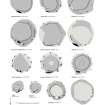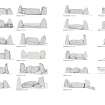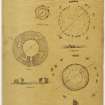Hatton Of Ardoyne
Recumbent Stone Circle (Neolithic) - (Bronze Age)
Site Name Hatton Of Ardoyne
Classification Recumbent Stone Circle (Neolithic) - (Bronze Age)
Alternative Name(s) Candle Hill
Canmore ID 18125
Site Number NJ62NE 7
NGR NJ 6598 2676
Datum OSGB36 - NGR
Permalink http://canmore.org.uk/site/18125
- Council Aberdeenshire
- Parish Oyne
- Former Region Grampian
- Former District Gordon
- Former County Aberdeenshire
NJ62NE 7 6598 2676.
(NJ 6598 2676) Stone Circle (NR)
OS 6" map, (1959)
Hatton of Ardoyne: a recumbent stone circle, 81ft (24.7m) in diameter, probably originally comprising 13 stones but now consisting of the recumbent stone, 8ft (2.4m) long and 5ft 4ins (1.6m) high, the SE flanker, over 7ft (2.1m) high, the base of the NW flanker, 5 erect stones, 4ft to 5ft 4ins (1.2 to 1.6m) high, and 1 prostrate, 6ft (1.8m) long. Two other stones, 3ft (0.9m) and 3ft 4ins (1m) high (at K-see plan) are unusual features - they cannot be part of an interior setting. According to Dalrymple (information from C E Dalrymple) there were two inner concentric circles 'raised one above the other like steps' 69ft (21m) and 64ft (19.5m) in diameter.
The outer circle, raised about a ft above the surrounding ground level, was faced all round with stones up to 18ins (0.45m) high and extending 2ft (0.6m) below ground. The inner circle was raised again but by not so much as the outer - the stones around the edge were smaller and not so deep-set.
A grave in the centre (oblong pecked out-line of plan), 5 1/2ft (1.67m) long, 1ft 9ins (0.53m) broad, and 4ft (1.2m) deep, paved with small boulders, on which was a small quantity of burnt bones, also contained small fragments of an urn 'burnt very red' at each end. It was filled in with earth, capped with another layer of small boulders. About 4ft (1.2m) from the NE end were small fragments of a similar urn.
Near stone D "a kind of grave, 6ft (1.8m) long, 4 (1.2m) wide and 2 1/2 (0.76m) deep, extended inwards from the foot of the standing stone to that of the smaller stones opposite, .... in which was a considerable quantity of black burnt stuff and charcoal, mixed with yellow clayey earth, and containing some stones marked with fire".
F R Coles 1902.
A recumbent stone circle comprising the recumbent stone and SE flanker as described, the probable stump of the new flanker, 3 erect stones (Coles [1902] plan C, E and I) and 2 displaced prostrate stones (D and G).
Stone J is part of a blasted monolith which has been moved to build a recent wall between the SE flanker and stone I. The two stones K, slabs set on edge, are incorporated in this wall, but are probably part of an orginal kerb which has terminated on the SE flanker and still in situ. This kerb can be traced for most of its periphery elsewhere about 2.0m within the ring of monoliths, except in the W where it is ploughed out. The ground within is level, and nothing intelligible survives. There is no trace of Dalrymple's two tiered concentric circles.
Resurveyed at 1/2500.
Visited by OS (NKB) 13 March 1969.
Air photographs: AAS/00/02/G2/11-12 and AAS/00/02/CT.
NMRS, MS/712/100.
Field Visit (2 July 1998)
This recumbent stone circle is situated in the saddle between Candle Hill and Roup Law, a position that looks SW across the valley of the Gadie Burn to the N slopes of Bennachie. The circle falls on a march that doubles as the boundary between two fields of improved pasture and is crossed by both a tumbled stone dyke and two wire fences. Originally comprising at least thirteen stones and measuring overall about 25m from NE to SW by 27m transversely, nine remained on the day of the survey in July 1998, made up of the recumbent (2), its E flanker (3) and seven orthostats (4–10); since then an additional stone has been set up within the circle adjacent to the S side of the march (not shown on the plan). The recumbent (2), which stands on the SW, is a modest slab with an even summit and measures about 2.45m in length by 1.95m in height. The W flanker is missing, but the E flanker (3) remains standing, a slender pillar 2.8m high slumped against the recumbent; its foot is aligned with the leading edge of the recumbent, and it rises into a point which appears to turn outwards, giving the setting a distinctive and immediately recognisable silhouette. Of the seven surviving orthostats, three are erect (5, 8 & 10), two have fallen close to their original positions (6 & 9) and two are displaced (4 & 7). Both the last two have been cut down, the one lying on the line of the kerb of the internal cairn on the S of the ring (4) exhibiting a shot-hole on one edge. Despite the damage to the circle, the heights of the flanker and the three orthostats that remain upright indicate that the circle was probably graded, reducing in height, though not spacing, from SW to NE. The flat-topped cairn within its interior is about 0.6m high and has measured about 22m in diameter over a graded kerb, though the present outline of the mound is heavily distorted on the NE and W by stone robbing. Nevertheless, at least twenty earthfast stones of the kerb are visible, principally on the N and S; they increase in size towards the recumbent setting, where the last two surviving on the E are massive boulders roughly 1m high. These two stones diverge from the projected line of the kerb to meet the recumbent setting, though whether this is a deliberate reconfiguration of an earlier line cannot be determined without excavation. A large kerbstone immediately E of the displaced orthostat on the S (4) exhibits two shallow cupmarks on its outer face. Among the irregularities in the surface of the cairn there is a lozenge-shaped depression extending from the centre towards the recumbent and traversed by the tumbled stone dyke. Measuring 10m from NE to SW by 3m transversely and 0.6m deep, this probably marks the position of one of the excavations made in about 1855 by Charles Dalrymple.
Visited by RCAHMS (ATW, IGP and KHJM) 2 July 1998






















































































